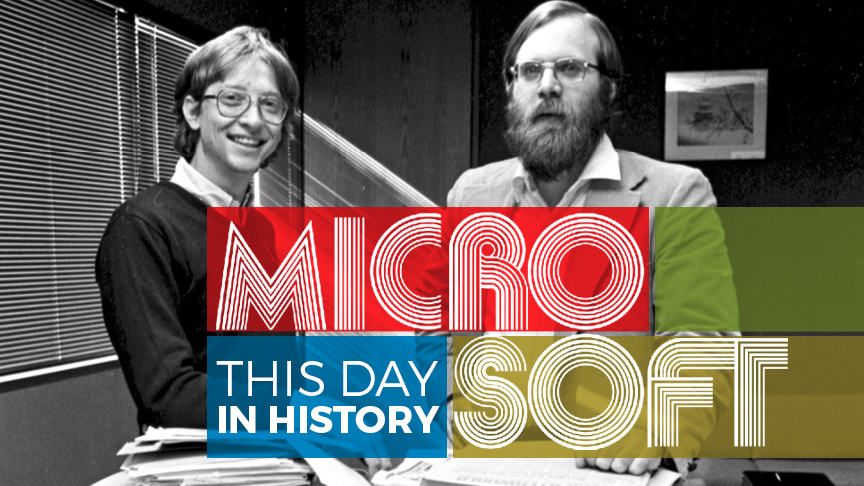This Day in Cyber History: Microsoft
We’re taking our series, This Week in Cyber History, a bit further with an installment of This Day in Cyber History. 44 years ago today, on April 4, 1975, Bill Gates and Paul Allen founded Microsoft.
A little walk down memory lane
Gates and Allen originally called their company Micro-Soft, representing microprocessors and software as they planned to create software for the personal computer, Altair 8800. Allen had been a programmer for Honeywell while Gates was still a student at Harvard.
Allen sold the maker of Altair, MITS (Micro Instrumentation and Telemetry Systems) on the idea of improving the performance of the personal computer. Gates and Allen worked non-stop to complete Basic. Allen moved to Albuquerque only to be joined by Gates who dropped out of his sophomore year.
The fledgling company also created versions of Basic for the hot-selling Apple II and Radio Shack’s TRS-80.
Microsoft’s sales topped more than $1 million in 1978 and the duo moved the company back home to Washington state in 1979.
In 1981, the company licensed its MS-DOS operating system to IBM for its first personal computer. This new operating system required users to type in commands to open a program.
In 1983, Allen departed Microsoft. He was diagnosed with Hodgkin’s lymphoma and stepped away from the company. While he was successfully treated for the disease, he never came back to Microsoft but went on to pursue other business ventures including ownership of the Seattle Seahawks and the Portland Trail Blazer, as well as technology and media companies and areas of scientific research. Allen died in 2018 after an unsuccessful battle with a recurrence of Hodkin’s lymphoma.
In 1985, Microsoft released a new operating system, Windows, with a graphical user interface that included drop-down menus, scroll bars and other features. The following year, the company moved its headquarters to Redmond, Washington, and went public at $21 a share, and raised $61 million.
Flashing forward to current day, in 2018, Microsoft delivered $110.4 billion in revenue with nearly 21% in commercial cloud business showcasing how Microsoft continues to innovate and lead.
Fun Facts regarding Microsoft
25 years ago, Novell, a competitor of Microsoft, announced that they had cornered the market on the DOS operating system by releasing their new and superior version of DOS called DR DOS. Novell thought that they would break into the client operating system market since Microsoft had halted future plans to improve its DOS product. In 1993, Microsoft ditched its 16bit platform to move to a 32bit platform with Windows NT. Novell thought that people would keep their old computers and switch MS-DOS to DR DOS. Why? It was DOS and the world was moving to Windows. Novell’s fortunes and stock price went down after that point as they bet wrong.
Novell started the IT certification process in the early 1990s. A CNE certification was highly coveted by practitioners. However, by 1997, a CNE certification was all but worthless, and the Microsoft MCSE was the certification to get since large businesses moved away from Novell servers to Microsoft. But hey, Novell had a better DOS product than Microsoft. Moral of this story: See the future, not the past.
Sometime in 1993, a person who was running Windows NT saw the screen turn blue and fill with random characters. That person is recorded as seeing the first of many “blue screens of death.” This is commonly known as a crash or fatal system error and generally also is accompanied by screams, sighs, and often a litany of expletives.
In 1995, Microsoft paid the Rolling Stones $3 million for the use of their song “Start Me Up” to be the anthem of its Windows 95 launch. Rumor has it that Bill Gates himself asked Mick Jagger how much it would cost and Jagger threw out a staggering number that years later was confirmed to be $3 million.
In 2010, Microsoft started their Cloud service known as Azure. Azure provides software as a service (SaaS), platform as a service (PaaS) and infrastructure as a service (IaaS). Currently, it is one of the most popular Cloud services, only behind Amazon in market share.
How do we help?
We offer nearly 40 training practice tests supporting Microsoft certifications and skills with more rolling out this year including Azure (AZ-100 and AZ-103) and Windows 10 (MD-100).
- Microsoft Azure
- Microsoft Exchange Server
- Microsoft Office 365
- Microsoft SQL Server
- Microsoft Visual Studio
- Windows Client
- Windows Server
Are you ready to become certified or add to your certification list? Learn more here.

